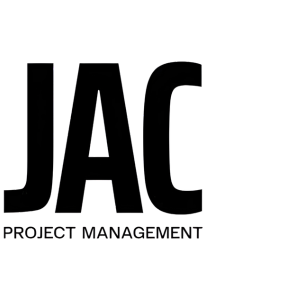Returning to the office after Covid-19
Returning to the Office
After Covid-19
When the time is right to return
to the office post Covid-19, we must do our
best to minimise risk and stay protected.
Some people will be looking forward
to the sense of community, while others
will have adapted to working from home.
We need to find a balance between being sociable
at work whilst adhering to social distancing rules.
Here are some tips from us in order
to make the transition as safe as possible,
pending further government guidelines…
Risk Assessments
- A workplace risk assessment – An assessment of the risks posed by COVID-19 should be carried out in the workplace as soon as possible. The results of the risk assessment should be shared with the workforce. If possible, results should be published on company websites (the government expects all employers with over 50 workers to do so). Further information on this can be found on the Government website.

- Communication – Ensure any updates to guidelines or working environments are communicated effectively to all staff.
Keeping Your Workspace Clean & Protected
- Regularly clean staff work area – Worktops should be cleaned after every use with an anti-bacterial spray. Staff keyboards, mice and phones should be given special attention (opt to use mobiles rather than desk phones when possible). Antibacterial wipes should be readily available for staff in the office to ensure surfaces, kit and desk area remains as clean as possible. Staff should have access to cleaning stations in order to do this. If you are cleaning after a known case of COVID-19 refer to specific guidelines.
- PPE – Workplaces should not encourage the precautionary use of extra PPE outside clinical settings. Unless you are in a situation where the risk of COVID-19 transmission is very high, risk assessments should reflect the fact that the role of PPE in providing additional protection is extremely limited. However, if the risk assessment does show that PPE is required, then PPE must be provided free of charge to workers who need it. Any PPE provided must fit properly.
- Face Coverings – A face covering can be very simple and may be worn in enclosed spaces where social distancing isn’t possible. It just needs to cover your mouth and nose. Employers should support their workers in using face coverings safely if they choose to wear one.
- Install protective screens – Screens can bring some extra security when using a workstation, whilst still allowing for social interaction with colleagues. We can investigate with your existing desk supplier the options they can put in place in order to assist with further protecting you as a user, be it an acrylic, perspex or fabric solution. It is highly recommended that screens are installed on reception desks.
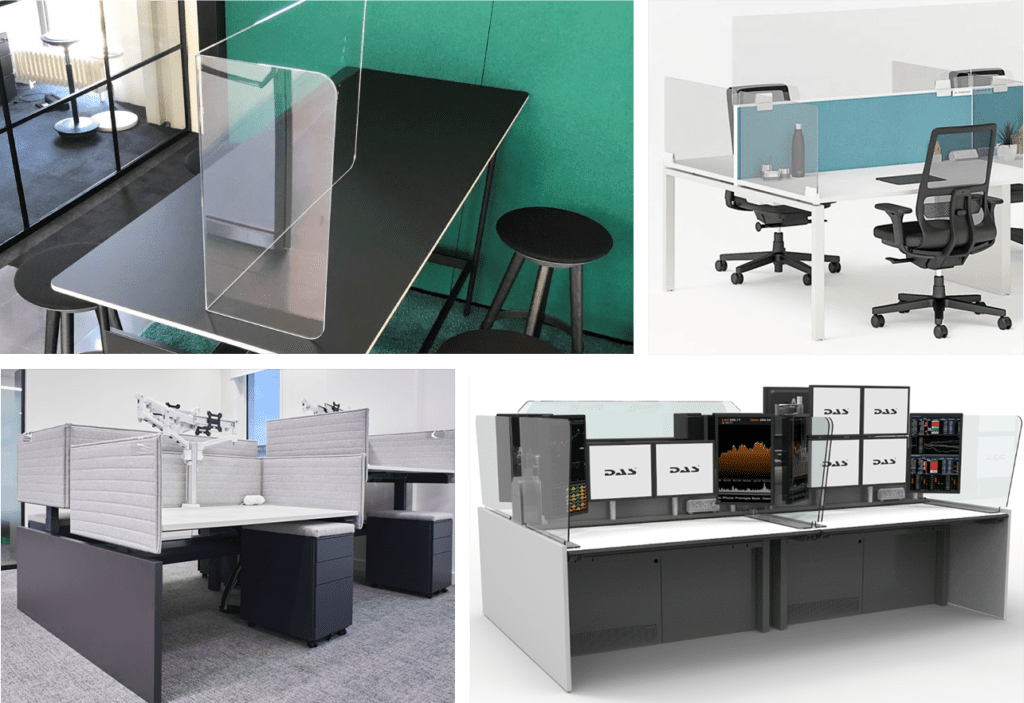
Physical Distancing
- Re-think your physical set up – The 2m social distancing rule should apply where possible in all areas of the workplace. We will need to be proactive in reconfiguring office spaces and desk arrangements. Social distancing will affect how and when we use our desks in shared and open plan environments. Using every other desk in a bank could be a way of ensuring there is enough space between people throughout the working day. Reception areas can also be reconfigured to allow for separate seating areas for visitors.
- Think about allocating desks – Staff could be allocated a desk for the duration of the day to prevent cross-contamination. Staff working on a shift basis should use the same desks positions if applicable.
- Consider use of storage – Review physical distancing around personal lockers, coat storage, stationery cupboards and other communal storage areas.
- Maximise remote working – It will be important to reduce the number of people using the space, encourage employees to work from home as much as possible. Monitor the wellbeing of people who are working from home and help them stay connected to the rest of the workforce.
- Laptops, wireless keyboards & mice – Should be provided to all employees if possible.
- Distancing markers – Areas where queues may form naturally (i.e. lift lobby, lavatory block, kitchen/tea-point, lockers) may require distancing markers.
- Guest protocol checklist – Consider writing a guest protocol checklist for when welcoming visitors into the office, and maintain a record of all visitors.
- Consider your printing practices – Use of the printer and how many people can use the device at one time.
Occupational Densities
Office occupation has become denser over the last 10 years or so. Desks have become smaller and more densely packed, meaning workers sit closer together which conflicts with social distancing. The trend to share desks may be reversed, with more desks being individually allocated to particular users.
- Reducing density on existing bench set ups – On back-to-back desks, see diagram below.
- Removal of furniture to encourage distancing – Staff can work further apart by separating single desks, and removing positions from workbenches. Spare chairs can also be removed to discourage use of extra space.
1200mm Desks:
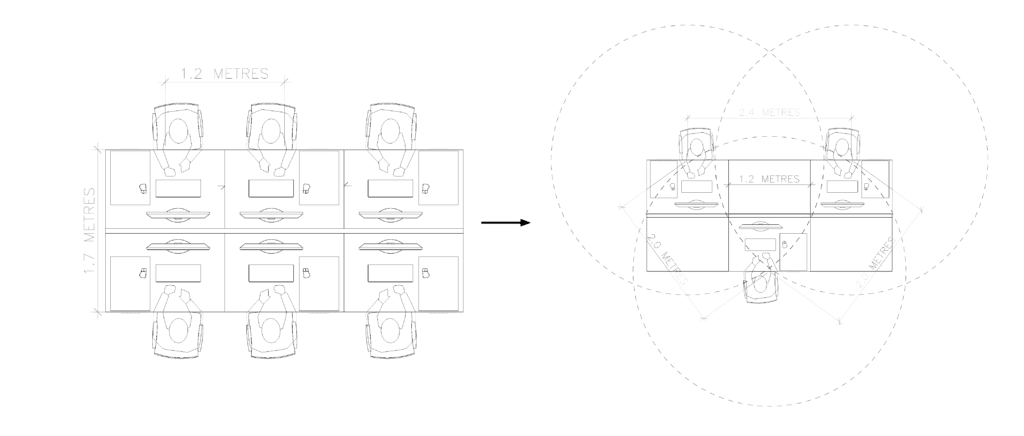
1400mm Desks:
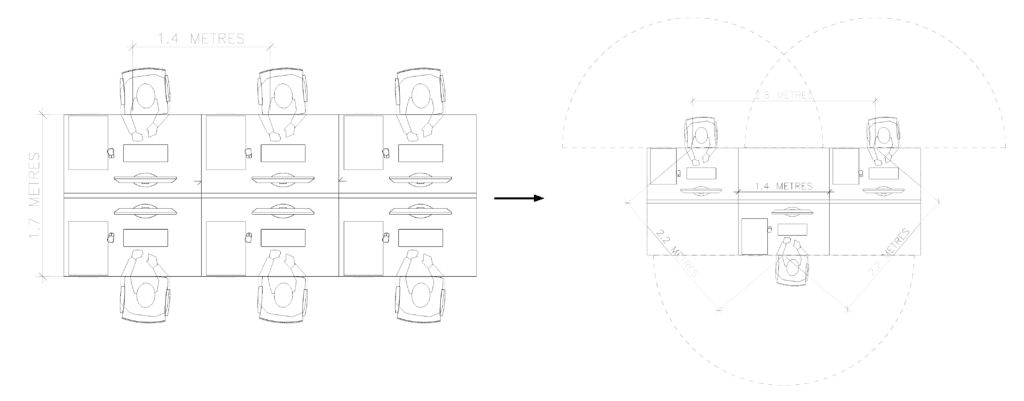
1600mm Desks:

Direction of Travel
- One-way systems – Introduce a one-way route around the office with arrows to decrease the risk of unnecessary interaction when walking around open plan space, if your layout permits.

Easy to Clean Fabrics & Surfaces
- Where possible introduce anti-microbial fabric – Choose performance fabrics and vinyls which all have anti-microbial properties, are bleach cleanable, waterproof and flame retardant.
- Clean upholstery regularly – Anti-microbial fabrics are cleanable with a 10% bleach solution. Usual maintenance and care principles can still apply.
- Introduce disposable desk surfaces – Disposable surfaces could be used on reception desks and collaboration tables whilst in use.
Divide Open Plan Offices
- Introduce mobile space dividers – Mobile space dividers are great to use to section off certain areas from larger spaces. Users can easily separate themselves away from larger areas to suit their needs.

- Create individual workspaces – Creating self-contained private and safe workspaces in an open plan environment can bring another level of flexibility. Acoustic rooms and pods can be configured to suit your needs.

- Meeting room usage – The number of people allowed in a meeting room should be prominently displayed in order to prevent overcrowding. Table and chair layouts should discourage close proximity of attendees. Appropriate cleaning measures are to be introduced between meetings.
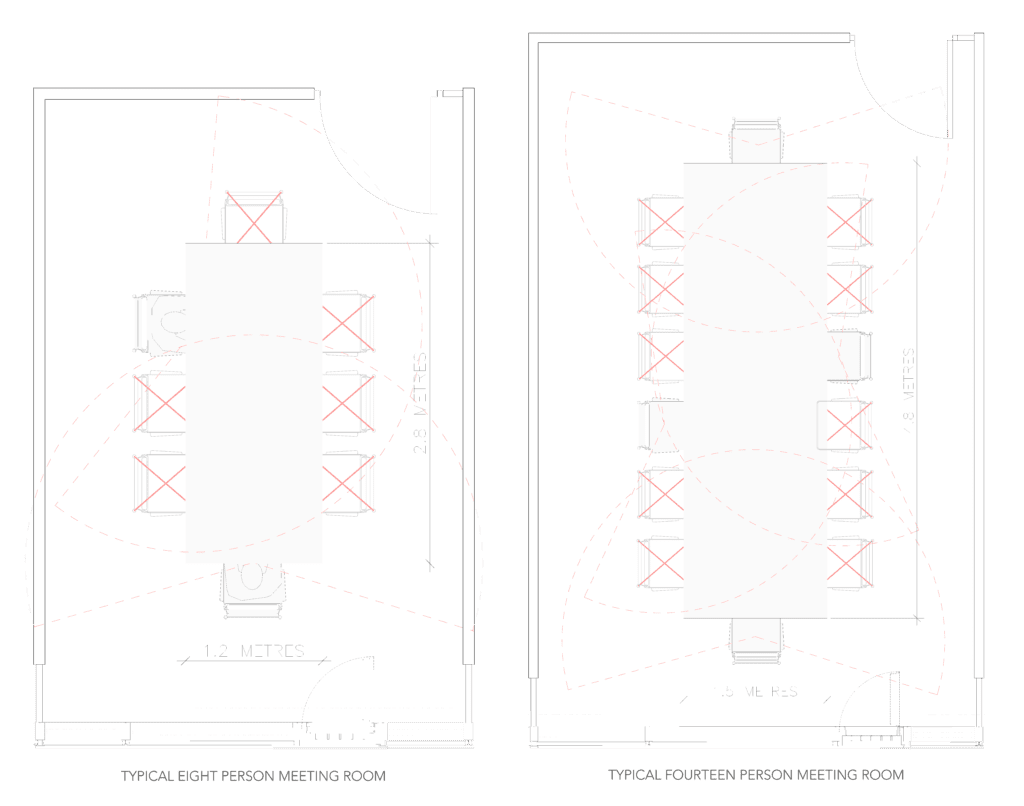
Note: Most meeting rooms of smaller sizes will end up being functional for far fewer users dependent upon the area within the room – possibly no more than 2 people.
Video conferencing – The need for face to face meetings should be reduced as workers gain familiarity with video conferencing. Meeting rooms should be kitted out with necessary equipment to encourage usage.
Staff Kitchen, Tea Points & Lavatories
- Staff breaks – It should be discussed how to manage staff taking breaks for coffees and lunch, and even going to the lavatory, on an allocated rotational basis, or using slots on a calendar system.
- Usage of disposable cutlery/crockery – In order to minimise use of shared items within kitchen and tea point areas, disposable items should be used where possible.
- Reducing clutter – Clutter on surfaces should be minimised to encourage frequent cleaning.
- Touch-free taps – Touch-free taps and dispensers should be used if possible. Cupboard doors could be omitted, to reduce common areas of contact.
- Visible cleaning – Implement cleaning shifts throughout the day and reinforce good hygiene practices with bold signage and communications. Hand washing is still the best way to reduce transmission of viruses.
- Toilet accommodation – Installation of a visible occupancy light could be installed outside the toilet facility in order to ensure staff do not clash when using the facility.
Building Services
- Natural ventilation – Actively use operable windows and openings to boost ventilation to occupied spaces as much as possible, even if this is at the expense of thermal comfort.
- Touch-free devices – The addition of a foot operated door opener may assist with reducing the number of times the door handle has to be touched (only possible on a latch-less door). Sensor taps, hand driers or automatic towel dispensers should be used wherever possible.

- Access into your building – Speak to your Building Manager about their plans when it comes to access and exit points within your office and how foot traffic can be managed. Consider the use of turnstiles, lifts and escalators.
Returning to the Office
After Covid-19
We know making sure that your office
is as safe as possible may be a
daunting task at this unfamiliar time.
We are here to help.
Please do call the JAC team and
we will assist in any way we can.
![]()
